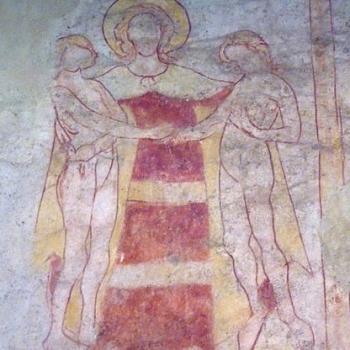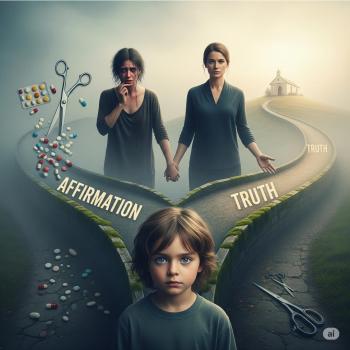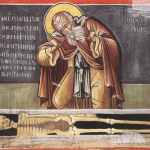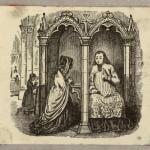 What is the true gospel (good news)? Does the Roman Catholic Church teach the true gospel or a false one? Protestants claim the 16th century Reformation was a rediscovery of the true gospel. They are unclear on whether this true gospel was misplaced or replaced by a false one in the deep annuls of church history. What is universally clear to all Protestants: Martin Luther rediscovered the true gospel and restored it to the church.
What is the true gospel (good news)? Does the Roman Catholic Church teach the true gospel or a false one? Protestants claim the 16th century Reformation was a rediscovery of the true gospel. They are unclear on whether this true gospel was misplaced or replaced by a false one in the deep annuls of church history. What is universally clear to all Protestants: Martin Luther rediscovered the true gospel and restored it to the church.
But did he?
The Gospel According to St. Paul
According to St. Paul, the gospel is the belief in the life, death, burial, and resurrection of Jesus Christ.
For I delivered to you as of first importance what I also received: that Christ died for our sins in accordance with the Scriptures, that he was buried, that he was raised on the third day in accordance with the Scriptures, and that he appeared to Cephas, then to the twelve. (1 Corinthians 15:3-5) [emphasis mine]
And we bring you the good news that what God promised to the fathers, this he has fulfilled to us their children by raising Jesus, as also it is written in the second Psalm,
‘You are my Son, today I have begotten you.’ (Acts 13: 32-33) [emphasis mine]
How does this compare to the official teaching of the Catholic Church?
The Gospel According to the Catholic Church
422 ‘But when the time had fully come, God sent forth his Son, born of a woman, born under the law, to redeem those who were under the law, so that we might receive adoption as sons.’ (Gal 4:4-5) This is ‘the gospel of Jesus Christ, the Son of God’ (Mk 1:1):’ God has visited his people. He has fulfilled the promise he made to Abraham and his descendants. He acted far beyond all expectation – he has sent his own ‘beloved Son’ (Mk 1:11; cf. Lk 1:5,68). (Catechism of the Catholic Church, paragraph 422)
Clearly, the true gospel is the gospel proclaimed by the Catholic Church. How does this gospel compare to that preached by Martin Luther and most Protestants who followed him?
Luther’s Gospel
According to Chuck Fry’s analysis of Luther’s Lectures on Galatians, Luther’s “true” gospel includes five key points:
-
The distinction between the law and the gospel
-
The doctrine of justification by faith alone
-
The definitions of repentance and faith
-
The bondage and inability of man’s will concerning salvation
-
The reality of sin in the Christian’s life and the subsequent need to live daily by the gospel
Fry goes on:
This leads us to the pure good news of the gospel. The gospel is an announcement about what Christ has done on our behalf. As both God and man, Jesus is the only one in all of history who could actually keep the law perfectly and have that obedience credited to us. Thus, there is no adding of our obedience to the work of Christ: no need for it, and no possibility of it. [emphasis mine]
St. Paul’s Warning
Therefore, for Fry, and other Protestants like him, the “true” and “pure” gospel not only includes a belief in the death, burial, and resurrection of Christ, but also adds more nuanced beliefs in how the believer understands the effects of this “true” and “pure” gospel. The gospel according to Luther is belief in the death, burial, and resurrection of Jesus, plus belief in five other beliefs, among them is faith alone. Furthermore, Luther and other Protestants who level a claim of “another” gospel taught by the Catholic Church would do well to heed St. Paul’s warning in Galatians 1:8-9 when they add five additional conditions to what the Bible declares as the gospel, especially when said additional conditions come from the personal musings of “theologians” cut off from legitimate apostolic authority.
The Gospel Effect
Now, the effects of the gospel on the believer differ between Catholics and Protestants. Catholics hold to the belief that justification is a process that includes sanctification. As a Catholic, I affirm that I was saved in baptism (1 Peter 3:21), currently saved by obedience of faith (Romans 1:5), and finally saved by completing the race and keeping my faith (2 Timothy 4:7). Moreover, the entire process relies entirely on the grace of God alone. I cannot save myself. Christ and Christ alone saves.
The Gospel’s Mark on the Soul
The gospel is not merely assent to a set of presupposed beliefs but it also transforms and changes those who assent.
For God has done what the law, weakened by the flesh, could not do. By sending his own Son in the likeness of sinful flesh and for sin, he condemned sin in the flesh, in order that the righteous requirement of the law might be fulfilled in us, who walk not according to the flesh but according to the Spirit. (Romans 8:3-4)
So we have come to know and to believe the love that God has for us. God is love, and whoever abides in love abides in God, and God abides in him. (1 John 4:16)
But when the goodness and loving kindness of God our Savior appeared, he saved us, not because of works done by us in righteousness, but according to his own mercy, by the washing of regeneration and renewal of the Holy Spirit, whom he poured out on us richly through Jesus Christ our Savior, so that being justified by his grace we might become heirs according to the hope of eternal life. (Titus 3:4-7)
Therefore, if anyone is in Christ, he is a new creation. The old has passed away; behold, the new has come. (2 Corinthians 5:17)
For if you live according to the flesh you will die, but if by the Spirit you put to death the deeds of the body, you will live. (Romans 8:13)
Therefore, brothers, be all the more diligent to confirm your calling and election, for if you practice these qualities you will never fall. (2 Peter 1:10)
Gospel and Sacraments
In a previous post titled Sacramental Logic: Incarnate Word and Sacrament, I explained the incarnational logic of sacramental theology. I can add here that the gospel, as understood as the life, death, burial, and resurrection of Jesus Christ, encompasses the incarnation and the sacraments. Therefore, through the Sacraments, we continually encounter the gospel in real and meaningful ways.
In Jesus, we have the touchable God. It is in this touch that we find the Sacraments. Moreover, we did not cease to need the physical presence of our Lord once He ascended into heaven. In fact, we needed it more. [From the article referenced above]
In the Sacraments, we touch the gospel as we receive the grace provided by them through the incarnate God.
The Gospel of Rome Revisited
The Catholic Church has always taught and will always teach the gospel (good news) of Christ. The Church teaches the Son of God became man, lived, died, buried, and rose again. The Catholic Church affirms this belief every time we profess the Nicaean/Constantinople Creed:
And in one Lord Jesus Christ, the Son of God, the Only-Begotten, begotten of the Father before all ages; Light of Light; True God of True God; begotten, not made; of one essence with the Father, by Whom all things were made; Who for us men and for our salvation came down from Heaven, and was incarnate of the Holy Spirit and the Virgin Mary, and became man and He was crucified for us under Pontius Pilate, and suffered, and was buried. And the third day He arose again, according to the Scriptures, and ascended into Heaven, and sits at the right hand of the Father; and He shall come again with glory to judge the living and the dead; Whose Kingdom shall have no end.
With this article I lay claim to the derogatory anti-Catholic term Romanist, for the Roman Catholic Church proclaims the true gospel. The Romanist gospel is the true gospel.
Like what you read? Please check out my other writing here.
Please like and follow me on Facebook.












